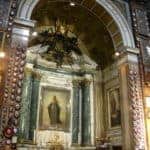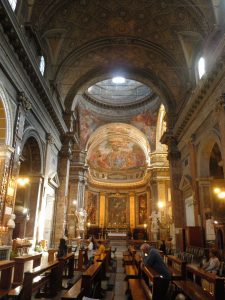About the Basilica di Sant’Andrea delle Fratte & Conversion of Alphonse Ratisbonne:
One of Rome’s many churches, this Basilica is closely related to the conversion of Alphonse Ratisbonne. Born in 1814 to a Jewish family in Strasbourg, France, Alphonse had an older brother, Theodor, who converted to Catholicism in 1827 and went on to become a Catholic priest. Alphonse, meantime, studied law in Paris and joined his family business. He was engaged to his niece (16 at the time) but due to her young age he had to wait sometime before marrying her.
In 1842 he traveled to Rome…..just for a vacation, not for any religious purpose. On January 20th of that year, he entered the Church of Sant’Andrea delle Fratte. At this point he was fiercely anti-Catholic but had been challenged to wear a Miraculous Medal, which he grudgingly did. You can read more details about how this came about here.


While wandering around the church he stopped at a side altar and suddenly had an apparition of the Blessed Virgin Mary. She appeared to him resembling the very image he had on his Miraculous Medal. He immediately decided to convert to the Catholic faith. Pope Gregory XVI immediately called for an investigation and it was decided that on January 20, 1842, a miracle had taken place: the instantaneous conversion of Alphonse Ratisbonne.
And it is also Pope Gregory XVI who approved the apparitions of the Miraculous Medal at Rue du Bac in Paris.
At his baptism, he added Marie to his name to reflect the role he felt that Our Lady had played in his life.
Alphonse returned to Paris later that year to proclaim his new-found faith to his fiancee, and invited her to share it with him, but she wanted nothing to do with it.
In June of 1842 he entered the Society of Jesus and was ordained as a priest in 1848. Later he left the Jesuits and joined his brother Theodore in founding the Congregation of Our Lady of Sion, dedicated to the conversion of the Jews.
Father Theodore spread his congregation throughout France and England, while Father Maria Alphonse went to the Holy Land . With the permission of Pope Pius IX, he left the Jesuits and moved the Sisters of Sion to Jerusalem in 1855. He built the Convent of Ecce Homo with a school and an orphanage for girls. Then, in 1860, he built the Convent of St. John on the mountain at Ein Karem, together with a church and another orphanage for girls. He, along with a few companions (called Pères de Sion) , continued to attemp the conversion of Jews and Muslims He also built the orphanage of St. Peter, near the Gate of Jaffa outside of Jerusalem, with a school for mechanical arts in the city.
Ratisbonne died in Ein Karem on May 6, 1884 (actually the same year that his brother died) and is buried in the cemetery of the Monastery.
We recommend this book from Amazon for a great read.
About the Basilica di Sant’Andrea delle Fratte:
The Basilica is beautiful (not unusual in Rome, of course) and has a magnificent Baroque fresco in the central with Bernini’s angelic sculptures on the side.
When visiting the Basilica, be sure to stop and pray at the side altar where the apparition took place, the Chapel of the Madonna…now often called the “altar of the miracle”. This is one of the highlights of a visit there.
An interesting note: This is the church where Saint Maximillian Kolbe celebrated his first Mass.
Finding the Basilica di Sant’Andrea delle Fratte:
The Basilica is quite close to the Spanish steps as well as the Trevi Fountain.
Address: Via di Capo le Case, 00187 Rome, Italy
Tel: +39 06 679 3191
Click here for the official website of the Basilica di Sant’Andrea delle Fratte

